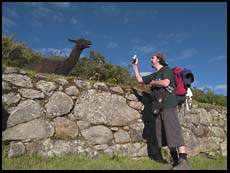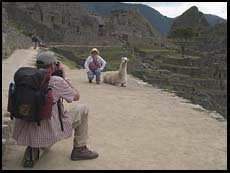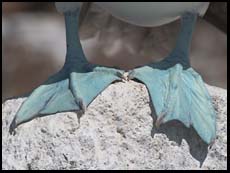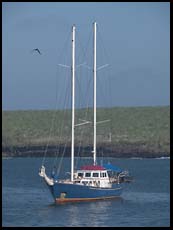
Olympus Digital SLR Cameras and Lenses
a photo.net guide by Philip Greenspun; revised May 2008
Site Home : Photography : Olympus System Explained

a photo.net guide by Philip Greenspun; revised May 2008
Site Home : Photography : Olympus System Explained
The Olympus system of digital single-lens reflex (SLR) bodies and lenses was a clean sheet of paper design, introduced in 2003. Olympus and Kodak asked the following questions:
Their answers were "No, no, and here is the Four Thirds system of cameras and lenses designed around a 13x17mm sensor." The result is the world's most compact camera system capable of professional results. The Olympus system should be seriously considered by photographers specializing in travel or those whose shoulders are aching. Note that the aspect ratio is 4:3 rather than the 3:2 of 35mm film and most digital cameras. The 4:3 aspect ratio is closer to old standard paper sizes, such as 8x10, 11x14, and 16x20, and older film formats, such as the 4x5 view camera. It is probably a better aspect ratio for portraits and not as good for landscape.
The Four Thirds system included a design for a brand-new lens mount. Functionally this is very similar to the Canon EOS lens mount, introduced in 1987, with an all-electronic interface between camera and lens. The mount diameter, however, was reduced from Canon's 54mm to about 44mm, similar to the Nikon F-mount. A 44mm on a film camera is a bit tight, but the dimension is vast compared to the size of the image circle for a Four Thirds sensor and therefore provides lens designers with a lot of flexibility. When looking at Four Thirds lenses, multiply by 2 to determine the 35mm equivalent in angle of view, e.g., a 14-42mm zoom lens for an E-system body will work the same as a 28-84mm lens on a 35mm film camera.
If you are new to photography, start with "Building a Digital SLR System."
At any one time, Olympus seems to make one body similar in capability
to midrange Canon and Nikon bodies and a bewildering array of light
inexpensive bodies with performance similar to the very cheapest
bodies from Canon or Nikon. All Olympus bodies are compatible with
Olympus Digital lenses and Four Thirds System lenses from Sigma and
Panasonic/Leica. The
Olympus was a pioneer in automated dust removal. All of the E-system bodies include a dust removal system that operates as the camera is switched off.

In looking at the megapixel numbers, you might be tempted to wonder how the Olympus system is competitive. There are point and shoot cameras with similar claimed resolution while the top-end Canon and Nikon bodies offer higher resolution. The 10-megapixel E-3 produces images that are 3648x2736 pixels in size. As explained in the Digital Cameras chapter of Making Photographs, 200 pixels per inch is sufficient for maximum image quality and prints from the E-3 should enlarge to 13.5x18" before suffering any quality loss due to a lack of resolution.

One of the nice things about Olympus is that they don't attempt to snow consumers with obscure acronyms. Nor does Olympus tack on fancy German brand names to lenses that they design and build. The Olympus America lens page refers to "super high grade", "high grade", and "standard" lenses.
"ED" is extra-low dispersion glass, a more expensive and higher-quality glass that reduces chromatic aberration or color fringing. All but the crummiest Olympus lenses include at least one ED element.
"Super ED" is, presumably, a newer more effective version of "ED", glass that reduces chromatic aberration or color fringing. Olympus does not explain what this means any more than Dean Wormer explained "double secret probation."
"SWD" is Supersonic Wave Drive, a piezoelectric motor that contributes to smooth and silent AF operation, similar to USM (ultrasonic motor) on Canon or AF-S (silent wave motor) on Nikon lenses.
"OM" are old Olympus film system lenses; they don't work on the modern
bodies without
All Olympus lenses incorporate modern multilayer anti-reflective coatings to improve contrast and light transmission. Mercifully Olympus does not have a brand name for their coating.

In the 1970s, Canon and Nikon were slugging it out with cameras that were progressively more capable, more rugged, and heavier. By the end of the decade, each company made SLRs that could be used to drive nails, capture the fastest sports cars, and weigh down the dead bodies of your enemies, dumped into the local river. Olympus took an alternative tack, introducing the light and compact Olympus OM-1 in 1972. Olympus delivered the fundamentals: bright viewfinder, through-the-lens metering, in-viewfinder displays, high quality lenses, and state-of-the-art electronics. These were delivered at roughly the same price as Canon and Nikon, but with a smaller size and lighter weight.
With a smaller market share and less capital than Canon or Nikon, Olympus came up with a feeble response to the demand for autofocus, gradually ceding market share to Canon EOS and Nikon AF. The OM-4 was the last camera of the line, introduced in 1983 and finally killed off in 2002.
By the year 2000, the Olympus OM system was a collectors' item and had very few day-to-day or professional users. This gave Olympus the freedom to chuck the frame size, lens mount, and legacy users. At the time, the Canon and Nikon digital SLRs on the market were small sensor models, wasting much of the image circle cast by the big legacy designed-for-film lenses. The challenge of engineering a consumer-priced 24x36mm sensor seemed insuperable. To an engineer, this was a ridiculous situation, as silly as a Nikon 35mm film photographer walking around with a bag of Hasselblad lenses designed to cover the 6x6cm medium format frame. The Olympus folks got together with a couple of partner companies and standardized a sensor size that would be reasonable to fabricate and a lens mount that would be correctly sized for the sensor size. The result was the Four Thirds system, with its 13x17mm sensor, which results in a 2X multiplier for effective lens perspective, e.g., a 25mm lens gives a normal perspective on an E-system camera, similar to a 50mm lens on a 35mm film camera.
(More: see www.four-thirds.org, quite possibly the world's worst-designed Web site.)

A normal lens is light in weight and approximates the perspective of the human eye. The focal length of a normal lens for the 13x17mm Four Thirds sensor should be between 22 and 25mm (compare to 43-50mm for a 35mm film camera). Normal lenses generally have large maximum apertures, indicated by small f-numbers such as f/1.4 or f/1.8, and therefore gather much more light than zoom lenses. It may be possible to take a photo with a normal lens in light only 1/8th or 1/16th as bright as would be required for the same photo with a consumer-priced zoom lens. Also, the viewfinder will be brighter and therefore easier to use in dim light, due to the fact that the large maximum aperture stays open for viewing and stops down to whatever aperture you have set just before taking the picture.
[Image at right was taken at a focal length of 22mm.]

A wide-to-tele zoom is what Olympus includes as a standard "kit" lens with their SLR bodies. The range on most of the Olympus wide-to-tele zooms starts at a moderately wide 14mm (28mm equivalent) and goes up to moderately telephoto. An all-purpose lens is good for when you are too busy to change lenses, for traveling when less weight and less baggage is better, or when working in a dusty or wet environment. When buying, watch out for slow maximum aperture, e.g., f/5.6 at the long end, which results in a dim viewfinder and the requirement to use a tripod or flash.

[Image at right was taken at a focal length of 14mm.]

In considering the use of telephoto zoom lenses for portraits, keep in mind that the small sensor results in more depth of field for a given angle of view. Suppose that the blur at 100/2.8 on a full-frame camera is sufficient to render the background non-distracting. The equivalent angle of view focal length for an Olympus body would be 50mm. Depth of field relates to the physical size of the aperture and 50/2.8 is a much smaller aperture than 100/2.8, therefore yielding much more depth of field. The background in this case may well be rendered sharp enough to serve as a distraction.
This is a simple section to write because Olympus has decided not to produce any rectilinear wide angle prime lenses. Fast primes in the 20-24mm range were favorites of photo journalists, but ever higher quality and faster wide angle zooms have reduced folks' interest in primes.

For situations where you can't get close to the subject, or want some perspective compression, a telephoto prime lens offers the best image quality and largest maximum aperture.
[Image at right was taken at a focal length of 200mm.]
Macro lenses let you photograph physically small objects, filling more of the frame with the object. The longer the focal length of the macro lens, the more space you can put between you and your subject. This is especially important when photographing insects. A macro lens that goes down to "1:1" can be used to take a frame-filling photo of something that is 13x17mm in size, the same dimensions as the sensor on a Four Thirds digital body. Most macro lenses can be used for ordinary photographic projects as well, i.e., they will focus out to infinity if desired.
A teleconverter provides additional magnification, but the overall amount of light gathered by the lens remains the same. Thus, you lose one f-stop of light with a 1.4x converter. The viewfinder will be dimmer and the camera will have a tougher time autofocusing. For autofocus with a 1.4x teleconverter, you generally need an f/4 or faster lens.
An in-body pop-up flash can be useful outdoors for filling in harsh shadows. When flash is providing the primary light, you'll need at least one hotshoe TTL flash. A hotshoe flash can be used to bounce light off the ceiling or walls. Often it is best to place the flash at a distance from the camera, then point it at the subject. The Olympus FL-CB02 hot shoe cable may be used to preserve communication between the body and flash or use the built-in wireless flash control of some E-system bodies (currently the E-3 is an example). Unless you want images that look as though the photographer was wearing a headlamp, try to come up with something other than direct on-camera flash.
All of the Olympus bodies accept CompactFlash cards, type I and II, and xD cards. CF cards have larger capacity for the price and are compatible with high-end Canon and Nikon bodies. We don't see any reason to recommend an xD card.
For a camera body and one lens, keep the camera around your neck and ready to use. To hold a camera system, start by reading the article on camera bags.

Compared to standard Canon and Nikon products, the Olympus E-system has several advantages for underwater photographers:
The best lenses for use underwater are wide-angle. Changing lenses underwater isn't too practical. Putting these two facts together, one concludes that the Olympus 7-14 is probably the best starter lens for the serious underwater photographer. If you want to get started with a smaller investment, the Olympus Stylus 1030SW is waterproof down to 33' and includes a 28mm equivalent wide-angle lens.
More: underwater photography primer.
Digital Cameras • E-10 • E-20 • E-1
Text copyright 2008 Philip Greenspun. Photos were taken in 2004 with an Olympus E-1 camera for the photo.net guide to Ecuador and Peru. Lenses were the 14-54 and 50-200.